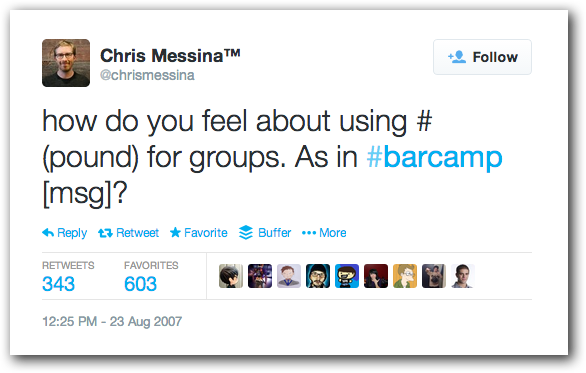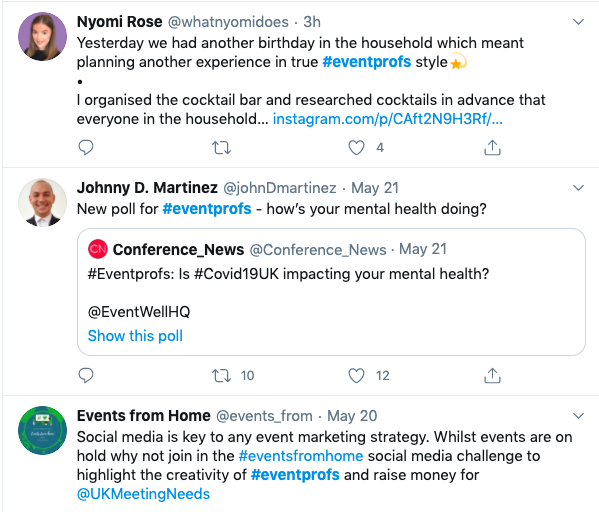Everything you ever wanted to know about hashtags but were afraid to ask your teenager.
Do you just need to know how to best use hashtags for a specific social media platform? Or how you can use them effectively for your small business, or how to avoid becoming the next social media horror story? If so, use this table of contents to jump to the section you need. Otherwise, read on!
- What is a hashtag?
- Why use hashtags?
- How #smallbiz can use hashtags effectively.
- How to use hashtags on Twitter.
- How to use hashtags on Instagram.
- How to use hashtags on Facebook.
- How to use hashtags on LinkedIn.
- How to use hashtags on YouTube.
- How to use hashtags on Pinterest.
- The dangers of hashtags.
- Jimmy Fallon shows you how to use hashtags.
- Next steps
(? While you're brushing up on hashtags in marketing, you should also check out our post on how to use emojis in your marketing and communications. It's mind-blowing! ?)
You see other people and businesses tossing around hashtags like #business, #entrepreneur or #marketing, and in your mind it's as accessible as juggling chainsaws.

 There's probably no easier way to tell a digital native from a digital naïve than their ability to use hashtags. Trying to use hashtags when you don't understand them sounds as natural as cursing in another language.
There's probably no easier way to tell a digital native from a digital naïve than their ability to use hashtags. Trying to use hashtags when you don't understand them sounds as natural as cursing in another language.
Whether it's during Q&A at social media conferences, in the comment sections of other posts, or in emails, I've fielded a lot of questions about how to use hashtags in social media, and answered most of them in this comprehensive guide.
Now, there are already a lot of great articles on how to use hashtags. However, most of them aren't geared toward small businesses and entrepreneurs (more on that later). So, I wanted to put together an exhaustive guide for small business owners and marketers for using hashtags in social media as it stands today.
What is a hashtag?
A hashtag is the pound sign. The sharp note in musical notation. A tic tac toe board. This: #
When it comes to social media, the hashtag is used to draw attention, organize, promote, and connect. They got their start on Twitter as a way of making it easier for people to find, follow, and contribute to a conversation.
Archeologists have unearthed this early tweet, and believe it to be the first time a pound sign was used for this purpose:

While they originated on Twitter, hashtags have now become an integral part of almost every social media platform today.
You don't need any special software, coding experience, or a college degree to create a hashtag. The only thing you need to do is put the pound sign directly in front of the word or phrase you want to turn into a hashtag and follow these simple rules:
- No spaces
- No punctuation
- No special characters
Another thing to keep in mind: capitalization only matters for readability.
#KnowWhatIMean?
Why use hashtags?
There are a number of reasons why you want to use hashtags in social media.
Hashtags help you get found by your target audience. When you use hashtags, your posts become searchable by anyone on that platform. Many people search specific hashtags, so by using hashtags that are of interest to your ideal customer, you increase the chances of being found.
Hashtags improve your clickthrough rates (CTR). According to research from Buddy Media, tweets with hashtags receive twice as much engagement as those that don't. Put another way, you can double your engagement and increase clickthrough rates by including hashtags.

You can check out the full infographic on Twitter engagement here.
Hashtags are great for research. If you are doing research, it's easy to find great and relevant content by searching specific hashtags. I've found that tweets with hashtags are generally more focused on a topic than a tweet that just mentions the phrase.

#Eventprofs is a longstanding hashtag for event professionals, in case you weren't sure.
Hashtags bring like-minded people together. Users with similar interests are able to interact with one another on social media; when they search hashtags of their interests, they are able to join a bigger conversation, and connect with others on that topic.
Hashtags can be used for humor. The hashtag is the social media equivalent of the aside or rimshot. While this may not help you get found in social media, it can certainly show your personality and help engage (or repel) your audience.

How #smallbiz can use hashtags effectively.
Many articles about how to use hashtags effectively reference a campaign from Esurance called #esurancesave30. The insurance company ran an ad after the Superbowl promoting the hashtag. As reported in Search Engine Watch, the hashtag was used 1.4 million times within an hour of airing the ad. Esurance also gained 40,000 followers within minutes and 250,000 followers in the next few days.
So…
Step 1: get a budget big enough to advertise after the SuperBowl
KIDDING! But really, what can a small business do when it comes to marketing with hashtags?
- Uncover the hashtags popular in your industry. While it is great to conceptualize your own hashtags, it's also beneficial to do some outside research. As hashtags have become more popular across social media platforms over the years, countless websites like AllHashtag have popped up that show you the top hashtags being used in your industry right now on any given platform.
- Make hashtags part of your regular posts. Consider using a tool like Agorapulse or Hootsuite to schedule a week's worth of social media posts beforehand, using industry-specific hashtags and links.
- Tailor your hashtags to each platform. While each social media site uses the same hashtag format (pound sign, no spaces or punctuation) each platform utilizes them slightly differently. For example, while #throwbackthursday is a major hashtag on Instagram, it doesn't mean anything on Pinterest. Below you'll discover the best ways to use hashtags by platform.
How to use hashtags on Twitter.
Twitter is where it all began for the hashtag. As I mentioned earlier, the first hashtag was used by a man named Chris Messina to create what he called “channels”– he even wrote an article about it back in 2007. Interestingly, Twitter didn't initially warm up to the idea, calling it too “nerdy”. It wasn't until 2009 that Twitter made hashtags an official part of their platform…nerds.

For some advice on using hashtags correctly on the platform that first birthed them, I reached out to Madalyn Sklar, host of the #TwitterSmarter podcast, to give us her best practices on using Twitter hashtags.

You can create your own hashtag that’s unique to your brand! It’s a way to bring your community together and allows you to stand out from the competition. If you’re going to go this route, you’ll want to make sure the hashtag you have in mind isn’t already being used by someone else.
It also needs to be memorable, especially if you want to encourage your community to use it as well. Oh, and don’t go overboard by making your branded hashtag too long. You don’t want it to take up too many characters.
Madalyn uses #TwitterSmarter as her branded hashtag both in Twitter chat, and to share valuable tips about the platform with users.
Madalyn also suggests hashtagging words that already appear in your tweet.

Doing this allows you to save space instead of taking up valuable characters by adding hashtags at the end.

Twitter chats.
Twitter chats (otherwise known as a Twitter party or Tweet chats) are monitored public conversations that focus on a particular topic. They occur when a group of people all use the same hashtag, forming a conversation thread. These discussions are planned ahead of time, and usually occur weekly, bi-weekly, or at announced times.
An example of a great recurring Twitter chat is the weekly #SmallBizChat. While their general topic is obviously small businesses, they focus on more specific topics week-to-week.

Chats are great ways of connecting with people on subjects you care about, whether it's cooking or marketing or hang gliding. You can search on hashtags you're interested in learning about, or on topics where you can establish your expertise.
Events.
Every year we put on The Agents of Change Digital Marketing Conference here in Portland, Maine. One of the ways we build excitement and engage the audience during the conference is through the use of hashtags.
Each year, we update the hashtag: #aoc2017, #aoc2018, #aoc2019 (and so on.) In all of our promotional tweets and other social shares, we include the hashtag. After attendees purchase their tickets, they're sent to a page with a clickable link allowing them to share on Twitter that they're attending; that tweet then goes out with the appropriate hashtag.
During the conference, we actively promote the use of the hashtag. In the “pre-roll,” the slides we show before the first speaker and during all the breaks, we actively promote the hashtag. We also had two of our employees “live tweeting” the event on our flyte new media and Agents of Change twitter accounts…each tweet including the most recent hashtag.
We also followed the hashtag that day, and retweeted what other attendees were saying and sharing about the event. After the event, we were able to capture some of the best moments by searching the conference hashtag.
How to use hashtags on Instagram.
Hashtags are the secret sauce of Instagram marketing. Because there's no easy method to share someone else's post, (known as “regramming,” similar to “retweeting” on Twitter,) hashtags become the number one way of reaching a new audience on Instagram.
Sue B. Zimmerman, a.k.a. #InstagramGal, shared some insights with me.

In order to attract your ideal follower on Instagram you have to have a hashtag strategy. Start with broad hashtags that represent your service or products then niche down to what keywords your clients would use to find you. For example I teach Instagram to business owners so these are my popular hashtags:
- #Online Marketing
- #Social Media
- #Entrepreneur
- #BusinessOwner
A more narrow target would be:
- #InstagramMarketing
- #InstagramforBusiness
- #LearnInstagram
Then specific to me:
- #RSGCommunity
- #suebtips
- #suebmademedoit
Hashtags become Hubs of content and you want to be a part of the Hub, i.e. the conversation.

Make Your Hashtags Count
There’s a common belief that using the max number of hashtags is always the best Instagram strategy. While it’s true you can use up to 30 hashtags, that doesn’t mean you should clutter your content with hashtags that are too broad or irrelevant to your content. Every hashtag is an opportunity to connect with a new follower, so you need to make every hashtag count. You should put your hashtags in the secondary comments, NOT the initial description, so that you can refresh your hashtags. I keep my hashtags in my notes on my iPhone to make them easy to grab and post.

When you are a newbie you should post your hashtags soon after you post. When you get more engagement and followers (over 500) you can post your hashtags hours later. I typically post in the morning before 8 am then go in at noon to add 6 hashtags. Days later I will delete the hashtags (follow my YouTube channel to see how) to refresh my post.
Getting New Followers
A great way to gain new followers is to follow the hashtags of events you attend.
Even before you step foot into the event, the event hashtag hub is an opportunity to connect with other attendees and speakers. Your content might even get the attention of the event organizers. By curating content on Instagram with this hashtag a community with common interest can be formed.
How to use hashtags on LinkedIn.
Hashtags first entered the LinkedIn scene in 2018, and while they've been a part of the platform for some time now, there is still a lot of uncertainty around how to use them. As a strictly professional platform, it's easy to understand the hesitancy you might be having diving into something unfamiliar. I turned to Viveka von Rosen, cofounder of Vengreso for a little clarity on the subject.

Hashtags are still definitely a thing onLinkedIn, and like the other Socials, they allow you to create and classify content that people can have conversations around. A friend of mine recently said,'Think of a hashtag as a fire that everyone gathers around in order to learn and share.' Not only that, but LinkedIn will actually promote and amplify through notifications, some posts, to a greater audience (what used to be HashtagCommunities–now more of a timeline.
Which Hashtags to Use
When using hashtags in posts, use a combination of popular hashtags: those which a lot of people are following (so that there's a chance your content will be amplified to a much bigger audience), and also some unique hashtags (one that we use is #VengresoVids) so you can find and amplify your own content. Anytime I do a Native video on LinkedIn, I'll use the hashtag #VengresoVids, which the rest of our team also uses. That way, it makes it really easy for me to find my own content. But other team members (who are using #VengresoVids as well,) can share and we all amplify each other’s content.
How to use hashtags on YouTube.
YouTube seems to be the most elusive platform in terms of hashtagging, so I checked in with Tim Schmoyer of Video Creators to get his take on using hashtags on YouTube.

While hashtags on YouTube are a feature that helps organize content similarly to any other platform, they're not utilized that often by creators nor viewers. The average YouTube viewer browses the platform and discovers new content through other traffic sources like home page placement, suggested videos, or search.

YouTube hashtags organize your content for you.
As Tim said above, YouTube is similar to many other platforms in the way it can help organize your content. However, YouTube has its own benefits for using them. By using hashtags, you are able to organize your content without having to create playlists for each topic. By using multiple hashtags on one post, that video is then added into multiple relevant groups, with very minimal work on your end.
You've decided to use YouTube hashtags, but where to put them?

If you do use hashtags on YouTube, they recommend using three hashtags or fewer and placing them either in the title or the description of the video. That will convert the hashtag text into a clickable link that displays other videos related to that hashtag.
How to use hashtags on Pinterest.
Pinterest has arguably been one of the most hot-and-cold platforms in terms of hashtags. While some seem to feel it's a worthwhile marketing strategy, others have said “Don't bother.” So, how should you feel about using Pinterest hashtags?
I asked Alisa Meredith of Alisa Meredith Marketing to weigh in on the subject.

When it comes to hashtags on Pinterest - they’re in, they’re out, they’re back, they’re optional! Given Pinterest’s sophisticated search algorithm, you use them if you like, but it’s no longer considered best practice. In fact, mention of hashtags recently disappeared from Pinterest’s content tips pages.
If you do choose to use hashtags, don’t use the ones that work on Instagram. #throwbackthursday doesn’t mean anything on Pinterest. Instead, use keywords someone might search to find your content. For instance, #marketingtips or #chickensalad.
As with everything else, test! Or, since they aren’t going to hurt you, you can go ahead and use them just in case they do help.
I also went straight to the horse's mouth and searched Pinterest's help pages to find their suggestions for using hashtags on their platform: “When inserting a hashtag, we recommend you be specific and descriptive. Use words or phrases that describe the content in the Pin – we recommend you add no more than 20 hashtags per Pin. It’s best to be objective and use hashtags that make sense and are relevant to the Pin.”
How to use hashtags on Facebook.
For a long time, the advice on using Facebook hashtags was: “Don't.”
For me, it still is. Case and point:

Now, it would be disingenuous and misleading for me not to mention that not everyone agrees. In the article, Hashtags on Facebook: Should You Use Them?, many social media experts–who I know and respect–suggest that there may be a place for hashtags on Facebook.
My big reasons for #NoHashtagsOnFacebook are these:
- Facebook has other tools for finding like-minded people, building community, and doing research, so the hashtag isn’t very useful.
- Because of that, hashtags aren’t how most people search or navigate on Facebook.
- Most hashtags that appear on Facebook are because the brand is posting the same message to multiple platforms at once. This is terrible social media etiquette, in effect saying, “I’m multitasking my social media and not giving this platform or you my full attention.” Even if that’s not the case, that’s the impression it leaves in many people's minds.
However, of all the arguments in that article, there was one that resonated with me. Both Peg Fitzpatrick and John Haydon suggest the use of hashtags on Facebook for branding purposes. If you have a branded hashtag for a campaign you’re using on other platforms, it makes sense to include it on social posts on Facebook.
The danger of using hashtags.
Before I let you go, let's just chat a moment about the potential downside of using hashtags on social media. Hashtags have been known to get some brands into trouble.
Look before you leap. It's a common tactic to use trending hashtags to gain visibility in social media.
In 2014, DiGiorno Pizza jumped on the hashtag #WhyIStayed, not realizing that it was being used to discuss domestic abuse.

While they did a good job of apologizing profusely, there's no denying damage was done to their brand. That's just one of hundreds of examples of brands not looking before they leap when it comes to trending topics.
Jimmy Fallon shows you how to use hashtags.
No complete guide to hashtags would be complete without Jimmy Fallon's video on hashtags:
Next steps with hashtags on social media marketing.
Hopefully you now feel comfortable using hashtags in your social media marketing. The best advice I can give you right now is to just go out and use them.
- Add them to your social media posts on Twitter, Instagram, LinkedIn, and (sometimes) Pinterest and YouTube.
- Create a branded hashtag for your company or event.
- Do research into specific niches by following relevant hashtags.
- Find like-minded people, brands, vendors, and customers through hashtags and engage with them.
Just remember that hashtags are the spice in social media, not the whole meal. A little goes a long way, and they can’t save a poorly throughout social media campaign.
If you made it all the way to the bottom of this article and you’re looking for help with hashtags, as well as developing and implementing a social media strategy that attracts and engages your ideal customers, well, that’s what we do! Give us a call today and we’ll help you build your audience on social media.
Rich Brooks



